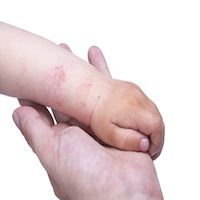Article
Childhood Atopic Dermatitis Does Not Commonly Continue to Adulthood
Author(s):

The majority of children with atopic dermatitis (AD) do not have the condition as adults; however, those who experience later onset or more severe disease are more likely to also experience disease persistence, according to a recent analysis of existing research. Published in The Journal of the American Academy of Dermatology and conducted by Jooho P. Kim, of the Department of Dermatology at Northwestern University Feinberg School of Medicine in Chicago, IL, and colleagues, the meta-analysis aimed to determine persistence rates of AD in the face of conflicting results of previous studies.
The authors identified 45 longitudinal studies to include in the analysis. There were 110,651 subjects from 15 countries across the included studies. The studies were published between 1955 and 2015, and the subjects ranged in age from .04 to 17.5 years. The researchers report “AD was diagnosed in 8.7% of subjects by age 5 years,” and “Duration of follow-up ranged from.25 to 23 years.”
“The median duration of AD persistence was 3 years,” said the researchers. After 3 years, there was a steep decline in rates of persistence. The researchers add, “In addition, persistence rates slowly continued to decrease, such that 80% of AD did not persist by 8 years and less than 5% of AD persisted by 20 years of follow-up.”
The age at which AD was first confirmed changed the likelihood of persistence. For subjects who received a diagnosis of AD between 0 and 1 year of age, the median persistence was 3 years. However, say the researchers, “the risk for overall disease persistence was significantly higher in children with AD onset at age 2 to 5 years compared with age of onset at 0 to 1 years, and peaked in those with onset at age 6 to 11 years.”
The authors note that studies that used self-reporting had significantly higher rates of persistence than those that used physician-assessed measures. Additionally, AD persistence was greater in females than males; but there were not significant differences in AD persistence among those with hypersensitivity to allergens and those subjects who were not sensitive to allergens.
“The results of this meta-analysis suggest that, overall, 80% of childhood AD did not persist by 8 years and less than 5% persisted by 20 years after diagnosis,” say the authors, but go on to conclude, “However, children with already persistent disease, later onset, and more severe disease were more likely to have disease persistence into adolescence and adulthood.”
Related Coverage:
Atopic Dermatitis: New Drugs Needed





